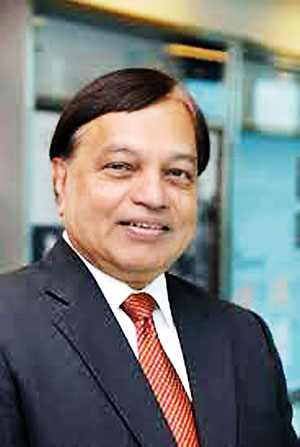News
SARS-buster on silent spreaders, safeguarding gains and more
View(s):As Sri Lanka gradually returns to the new normal with only sporadic full-day curfews being imposed, the Sunday Times interviewed SARS-buster Prof. Malik Peiris, Professor of Virology at the School of Public Health, Hong Kong University, on some of the latest developments.
Now that Sri Lanka has eased the lockdown and lifted the curfew, should we expect a second wave of infection? If so, how could we meet this?

Prof. Malik Peiris
A. Clearly lockdowns cannot be maintained indefinitely. Hong Kong never had a ‘lockdown’ in the way it was enforced in Sri Lanka or even the United States of America (USA) or Europe. What we have in Hong Kong was aggressive social distancing, i.e. people who can work from home have been asked to do so; shifts have been staggered; large gatherings of people are banned; and places where large numbers of people gather were discouraged in doing so. Even restaurants could only admit <50% of the normal capacity and each table had to be 1.5 metres apart. People used hand hygiene and masks. Non-essential travel is discouraged. This was coupled with aggressive testing of everyone with pneumonia, everyone with any respiratory disease with fever, coupled with contact tracing and quarantine.
So, as Sri Lanka comes out of the lockdown, it is important to maintain some of these social distancing measures. These have to be fine-tuned for different countries and populations. But the principle remains the same – reduce the opportunity for the virus to transmit from one person to another.
Has the new coronavirus profile changed? What of the different virus strains affecting different countries?
Like any other RNA (ribonucleic acid) virus, the SARS-CoV-2 also continually undergoes mutations. But there is no reliable and convincing evidence that these mutations have any relevance to disease severity.
Do you think the Sri Lankan returnees from abroad are bringing in a more virulent strain? Or is it the same as the one doing the rounds in Sri Lanka?
As said earlier, these strains do not relate to disease severity.
Are middle-aged people also more prone to contracting COVID-19 and if so are they also more prone for critical illness? Has it changed from older people falling into this category?
People of any age including children can get the COVID-19 infection. But children and young adults get mainly mild disease or are even asymptomatic. It is not susceptibility to infection that is the difference with age (though some studies suggest slightly lower susceptibility of children). The difference is the severity of disease. With increasing age or the presence of co-morbidities (like diabetes, obesity, hypertension, etc.) the greater the probability that the infection would lead to significant disease. Most of the deaths are in the older population – >65 or 70 years.
But it is, of course, possible that when large numbers of younger adults get infected, a small number will also get very sick and may even die. It is all a matter of probabilities.
With larger numbers of children also getting infected in Europe and USA, it is now being realized that children can develop an unusual “inflammatory syndrome” which can be quite serious.
With RT-PCR being the gold standard in diagnosing COVID-19, what are your views on good antibody testing to check out how many have been exposed to the virus?
RT-PCR remains the mainstay of diagnosing patients. We and others have shown that sensitivity of serology tests is low in the first week of the illness. Serology tests are useful (and we are using them now) to look at population surveys to define how many people have been infected in high-risk groups, where outbreaks have taken place.
What of ‘silent’ spreaders of COVID-19?
It is now recognized that there are asymptomatic infections and that they can be spreading the virus to others in an “invisible” way because these people have no symptoms.
Our group at the HKU has also found evidence of “super-spreaders”. That is that roughly 80% of infections are caused by 20% of infected people. This means that the majority of infected people do not infect anyone, a few infect a few and 20% infect that majority.
| J’pura & Oxford team up for immunology research The Sri Jayewardenepura University’s Centre for Dengue Research – Allergy, Immunology & Cell Biology Unit – along with the MRC Weatherall Institute of Molecular Medicine, University of Oxford, will conduct crucial immunology research linked to COVID-19. They will study the immune responses of COVID-19 patients in different populations and the British High Commission has supported this research with Rs. 10 million in new funding. The Centre for Dengue Research has been working with the Oxford University on dengue studies for more than 12 years and is now set to expand its work to include COVID-19 studies. Ibuprofen studies and sniffer dogs in the UK Researchers at the Guy’s and St. Thomas’ Hospital and King’s College London, United Kingdom (UK) are studying whether the anti-inflammatory drug, Ibuprofen, can reduce the serious side-effects of COVID-19, shortening hospital stays. Studies using Ibuprofen in animals having acute respiratory distress syndrome have shown positive results and human clinical trials are due on hospitalized patients, it is reported. However, in the initial stages of the pandemic, French authorities advised against the use of Ibuprofen.
Sniffer dogs on the trail of COVID-19 The first phase to be led by the London School of Hygiene & Tropical Medicine, along with the Medical Detection Dogs charity and Durham University, will use specialist medical sniffer dogs, Norman, Digby, Storm, Star, Jasper and Asher. Medical sniffer dogs are already trained to detect odours of certain cancers, malaria and Parkinson’s disease. | |


